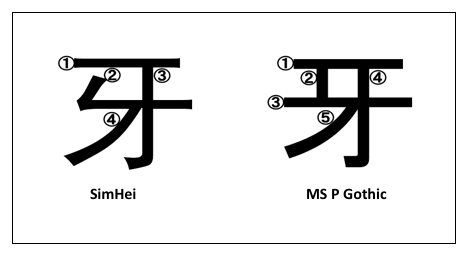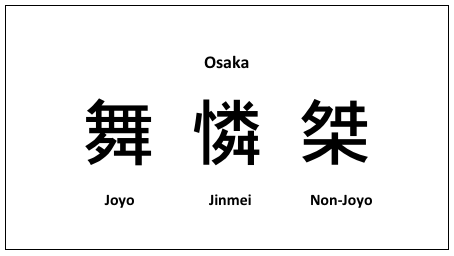Sticky Stroke Counts
To locate characters in dictionaries, you may need to determine the stroke count. This can be tricky. For instance, you might not know whether a corner represents a break between strokes or whether the line continues around the bend.
As if this sort of confusion weren't enough, the shape of some radicals actually changes under certain conditions, and this affects the stroke count. Let's look at a few of these sticky situations.
Radical 92: The "Tusk" Radical
If you've read essay 1972 on 牙, you're already familiar with this character:
牙 (1972: tusk, fang; "tusk" radical)
As an autonomous kanji, 牙 officially has four strokes.

However, the stroke count of this shape varies with the font. Here are two stroke-order diagrams of 牙, shown in the SimHei font on the left, MS P Gothic on the right.

Most Japanese fonts use the five-stroke form shown on the right.
Various operating systems also affect the way these characters appear. My proofreader says that with Windows XP, he sees 牙 in its five-stroke form. With Windows 7, he sees the four-stroke form.
When 牙 (radical 92) is part of other Joyo characters, it officially has five strokes:
芽 (434: bud)
艹 (3 strokes) + 牙 (5 strokes) = 8 strokes
雅 (1057: elegant)
牙 (5 strokes) + 隹 (8 strokes) = 13 strokes
邪 (1340: injustice, wicked, wrong)
牙 (5 strokes) + 阝(3 strokes) = 8 strokes
If you look at these three kanji closely, you'll notice that 牙 resembles the right-hand shape above, the one with five strokes.
As a component in Jinmei kanji, 牙 still has five strokes. Jinmei is an abbreviation for 人名用漢字 (じんめいようかんじ: kanji for people's names). These are kanji that fall outside the Joyo set but that the government has deemed permissible in people's names. That is, any character that doesn't qualify as Joyo or Jinmei can't appear in a newborn's name. Here's an example of a Jinmei kanji with 牙 as a component:
冴 (to be clear; cold; serene; skillful)
冫(2 strokes) + 牙 (5 strokes) = 7 strokes
Actually, 冴 is the only Jinmei kanji with the five-stroke 牙 as a component (so our rule isn't much of a rule here!). The only other Jinmei character to include 牙 is 穿 (to penetrate, dig, drill, pierce). In that kanji, 牙 has just four strokes. Here's why: When 冴 entered the Jinmei set in 1976, its 牙 component had only four strokes, but the government revised that in 1981, giving the 牙 in 冴 an extra stroke. In 2004, 穿 became a Jinmei character with a four-stroke 牙, and this has never changed.
When 牙 is part of non-Joyo kanji, it looks more like the SimHei character displayed above, and the dictionary Kanjigen considers it to have just four strokes! Here is an example:
訝 (doubt)
言 (7 strokes) + 牙 (4 strokes) = 11 strokes
Actually, on my Mac, the 牙 in 訝 is closer to the five-stroke MS P Gothic shape than to the SimHei shape. That's also true if you use Windows XP or Android, to name just a few examples. However, here's how 訝 looks in Windows 7, where the 牙 has just four strokes:

Incidentally, if you consult Denshi Jisho about this character or about 牙 itself, you'll see multiple stroke counts:
牙 4, 5 strokes
訝 11, 12 strokes
Denshi Jisho does not offer this type of choice with the three Joyo characters listed above, the ones that contain 牙. For those, the stroke counts are definitive. But 牙 itself is a Joyo kanji, so you may wonder why there's any ambiguity in that case. Some dictionaries say that this kanji originally had four strokes but is considered correct even if it's written with five. My proofreader (who went to elementary school in the 1970s) says his teachers and textbooks presented this character as having five strokes. Denshi Jisho, then, must be covering all the bases.
Radical 136: The "Dancing Legs" Radical
Much of what I've said about 牙 also applies to radical 136, 舛. Here it is as an autonomous, non-Joyo kanji:
舛 (セン, ます, まいあし: to go against, disobey, rebel)
As such, it has six strokes according to Kanjigen, though Denshi Jisho disagrees and says that 舛 has seven.
Here's this shape again as a radical:
舛 ("dancing legs" radical)
Inside Joyo kanji, this radical has seven strokes:
舞 (1761: to dance)
無 (8 strokes) + 舛 (7 strokes) = 15 strokes
隣 (1915: neighboring)
阝(3 strokes) + 米 (6 strokes) + 舛 (7 strokes) = 16 strokes
Note that radical 136 is just a component in 隣, not the on-duty radical.
In Jinmei kanji, the component 舛 again has seven strokes:
憐 (compassion)
忄(3 strokes) + 米 (6 strokes) + 舛 (7 strokes) = 16 strokes
舜 (type of morning glory)
爪 (4 strokes) + 冖 (2 strokes) + 舛 (7 strokes) = 13 strokes
By contrast, this shape has just six strokes inside the following non-Joyo character, according to Kanjigen:
桀 (ケツ, ゲチ, かか•げる: measuring box)
舛 (6 strokes) + 木 (4 strokes) = 10 strokes
Although the stroke count of the right side of 舛 varies in Joyo and Jinmei versus non-Joyo characters, its shape actually remains the same across the board in certain fonts. That's true in the display here.

Radical 71: The "Crooked Heaven" Radical
Radical 71, the "crooked heaven" radical, looks a lot like 牙 but behaves differently. Rather, I should say that the variant of this radical looks like 牙. The "crooked heaven" radical consists of 无 as the parent version and 旡 as the variant:
无 ("crooked heaven" radical, parent version)
旡 ("crooked heaven" radical, a variant of 无)
Incidentally, each of these can function as an autonomous non-Joyo kanji:
无 (ブ, ム, な•い: not to exist; nothing)
旡 (キ, ケ, つ•まる, つ•くす: to clog; do completely; something clogs up because it gets filled; to eat up; the state of doing the previous things)
As autonomous characters, they have no relationship to one another.
When the "crooked heaven" radical appears inside other kanji, it always takes the form of the variant 旡, not 无, the parent. That's one absentee parent!
The 旡 shape appears in three Joyo kanji. It's a component in 慨 (1070: to lament; resent) and 概 (1072: approximation; outline; general), whereas it's a radical in this character:
既 (1126: already)
艮 (5 strokes) + 旡 (5 strokes) = 10 strokes
As you can see, the 旡 radical has five strokes here. So does the component on the left side of 既, even though it has six strokes in 艮, which is its pure form.
According to Kanjigen, 旡 has five strokes in both Joyo and Jinmei characters. In the following Jinmei kanji, "crooked heaven" is a component and has five strokes:
 (キュウ, うまや: barn, stable)
(キュウ, うまや: barn, stable)
厂 (2 strokes) +皀 (7 strokes) + 旡 (5 strokes) = 14 strokes
(The Jinmei kanji appears here as an image, not as text, because it's not electronically supported on every system.)
Meanwhile, in kanji that meet neither of those criteria, Kanjigen generally considers the "crooked heaven" radical to have just four strokes. The following variant of 厩 is one example:
廐 (キュウ, うまや: barn, stable)
广 (3 strokes) + 皀 (7 strokes) + 旡 (4 strokes) = 14 strokes
Here, the 旡 looks as if it maintains its shape, which makes the change in stroke count puzzling. Well, the shape may or may not change. It all depends on the font. Here are the same three characters in a much larger point size and in two fonts:

In the MS P Gothic row, 旡 looks the same in every case. But look at the Osaka line. In the first two kanji, rigidly perpendicular lines meet at a corner on the left of 旡. In the final character, the same strokes meld into a somewhat fluid line. This supports the notion of a lower stroke count for this category. But why doesn't MS P Gothic (among other fonts) reflect this concept? It turns out that even font designers find the issue complicated! As my proofreader explains, "The shape significantly depends on the font designer’s discretion. Apparently, the designer was aware of the difference for 牙 but not for 旡." That's amazing! All of us now know more than some Japanese font designers!
Now for another odd situation. "Crooked heaven" is a five-stroke component in the next kanji, even though it belongs to neither the Joyo nor the Jinmei sets:
漑 (カイ, ガイ, そそ•ぐ: to pour)
氵(3 strokes) + 皀 (7 strokes) + 旡 (5 strokes) = 15 strokes
What's the story here? Well, it turns out that the Japanese government has defined a "standard printed shape" for certain non-Joyo kanji, including this one, and more than a thousand others, as you can see in this table, in which "our" kanji is in row 119. The government has deemed that this character should have five strokes.
Implications for Dictionary Searches
According to my proofreader, many kanji dictionaries present two forms for each of the characters in question here. Those books are designed so that you can find kanji with both stroke counts. When this is not the case, he says, "You have to know if the kanji is Joyo or Jinmei before you can tell how many strokes it has." Yikes! Just one more area for kanji obsessives to master.
